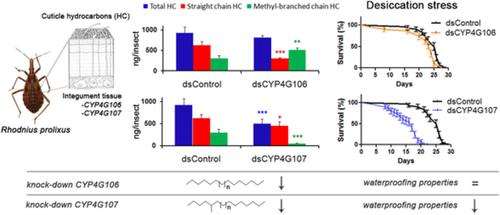当前位置:
X-MOL 学术
›
Insect Mol. Biol.
›
论文详情
Our official English website, www.x-mol.net, welcomes your
feedback! (Note: you will need to create a separate account there.)
Deciphering the role of Rhodnius prolixus CYP4G genes in straight and methyl-branched hydrocarbon formation and in desiccation tolerance.
Insect Molecular Biology ( IF 2.3 ) Pub Date : 2020-08-07 , DOI: 10.1111/imb.12653 A B Dulbecco 1 , D E Moriconi 1 , S Lynn 2 , A McCarthy 2 , M P Juárez 1 , J R Girotti 1 , G M Calderón-Fernández 1
Insect Molecular Biology ( IF 2.3 ) Pub Date : 2020-08-07 , DOI: 10.1111/imb.12653 A B Dulbecco 1 , D E Moriconi 1 , S Lynn 2 , A McCarthy 2 , M P Juárez 1 , J R Girotti 1 , G M Calderón-Fernández 1
Affiliation

|
Insect cuticle hydrocarbons are involved primarily in waterproofing the cuticle, but also participate in chemical communication and regulate the penetration of insecticides and microorganisms. The last step in insect hydrocarbon biosynthesis is carried out by an insect‐specific cytochrome P450 of the 4G subfamily (CYP4G). Two genes (CYP4G106 and CYP4G107) have been reported in the triatomines Rhodnius prolixus and Triatoma infestans. In this work, their molecular and functional characterization is carried out in R. prolixus, and their relevance to insect survival is assessed. Both genes are expressed almost exclusively in the integument and have an expression pattern dependent on the developmental stage and feeding status. CYP4G106 silencing diminished significantly the straight‐chain hydrocarbon production while a significant reduction – mostly of methyl‐branched chain hydrocarbons – was observed after CYP4G107 silencing. Molecular docking analyses using different aldehydes as hydrocarbon precursors predicted a better fit of straight‐chain aldehydes with CYP4G106 and methyl‐branched aldehydes with CYP4G107. Survival bioassays exposing the silenced insects to desiccation stress showed that CYP4G107 is determinant for the waterproofing properties of the R. prolixus cuticle. This is the first report on the in vivo specificity of two CYP4Gs to make mostly straight or methyl‐branched hydrocarbons, and also on their differential contribution to insect desiccation.
中文翻译:

解释Rhodnius prolixus CYP4G基因在直链和甲基支链烃形成以及干燥耐性中的作用。
昆虫表皮碳氢化合物主要参与表皮的防水,但也参与化学通讯并调节杀虫剂和微生物的渗透。昆虫碳氢化合物生物合成的最后一步是通过4G子家族(CYP4G)的昆虫特异性细胞色素P450进行的。在Triatomines rhodnius prolixus和Triatoma infestans中报道了两个基因(CYP4G106和CYP4G107)。在这项工作中,它们的分子和功能表征在R中进行。lix,并评估它们与昆虫存活的相关性。两种基因几乎都在被膜中表达,并且其表达模式取决于发育阶段和进食状态。CYP4G106沉默显著不减直链烃的生产而显著减少-主要是甲基支链烃的-被后观察CYP4G107沉默。使用不同醛作为烃前体的分子对接分析预测,直链醛与CYP4G106和甲基支链醛与CYP4G107更好地匹配。存活的生物测定法将沉默的昆虫暴露在干燥压力下表明CYP4G107是R的防水性能的决定因素。蝽角质层。这是关于两种CYP4G在体内主要制备直链或甲基支链烃的体内特异性的第一份报告,同时还涉及它们对昆虫干燥的不同贡献。
更新日期:2020-08-07
中文翻译:

解释Rhodnius prolixus CYP4G基因在直链和甲基支链烃形成以及干燥耐性中的作用。
昆虫表皮碳氢化合物主要参与表皮的防水,但也参与化学通讯并调节杀虫剂和微生物的渗透。昆虫碳氢化合物生物合成的最后一步是通过4G子家族(CYP4G)的昆虫特异性细胞色素P450进行的。在Triatomines rhodnius prolixus和Triatoma infestans中报道了两个基因(CYP4G106和CYP4G107)。在这项工作中,它们的分子和功能表征在R中进行。lix,并评估它们与昆虫存活的相关性。两种基因几乎都在被膜中表达,并且其表达模式取决于发育阶段和进食状态。CYP4G106沉默显著不减直链烃的生产而显著减少-主要是甲基支链烃的-被后观察CYP4G107沉默。使用不同醛作为烃前体的分子对接分析预测,直链醛与CYP4G106和甲基支链醛与CYP4G107更好地匹配。存活的生物测定法将沉默的昆虫暴露在干燥压力下表明CYP4G107是R的防水性能的决定因素。蝽角质层。这是关于两种CYP4G在体内主要制备直链或甲基支链烃的体内特异性的第一份报告,同时还涉及它们对昆虫干燥的不同贡献。











































 京公网安备 11010802027423号
京公网安备 11010802027423号